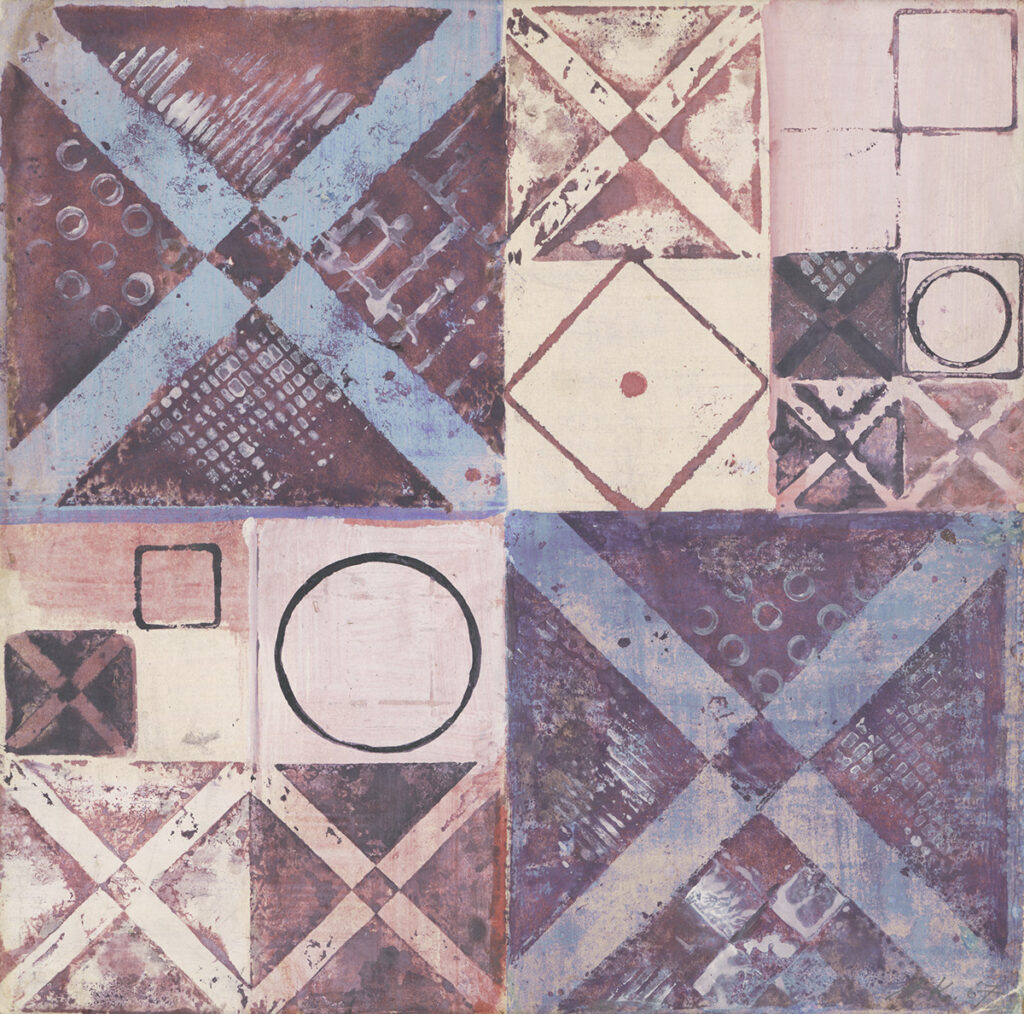Alojz Klimo, together Milan Dobeš and Miloš Urbásek, is considered to be the founding representative of constructionist and geometrical art in Slovakia. He was the first who started with the reduction of the painting’s space into elementary geometrical forms.1
He developed his art program gradually. By the end of the 1950s he was known for his expressive paintings, inspired by prewar European modernism. On the other hand his graphic paintings and drawings came out of national and folk tradition. As an artist fascinated by technology, city, architecture and industrial landscape he started to reduce the expression means he had used in the first half of the 1960 and moved progressively to abstraction. By the end of the 1960 his works can be characterized by signs, symbols, and pictograms that serve as metaphorical commentary on contemporary civilization, its positive and negative manifestations. The elementary building stones of Klimo’s artistic language are squares, rectangles, triangles, and circles used in multiple variations in a wide spectrum of motifs. He was able to make the space of the painting dynamic and to bring out creative tension – his paintings are therefore not only static still-lives analyzing the formal possibilities of geometrical art.
The work Small Crossroads III (Malé križovatky III) is a tempera painting of a smaller format on paper adjusted to wood fiberboard and belongs among the works from his most significant and known series of paintings titled Crossroadsthat Klimo created from 1966 to 1969.2 Another very well known series is Windows (Okná) from which Nitra Gallery also has one piece in its collection.
The painting is a composition of geometrical forms with a distinct and dynamic division into four diagonally varied square surfaces whereas the main motif of a crossroad recurs in all four fields. The composition resembles a ground plan or a view from above on a kind of traffic lines that are important to secure movement within an urban organism. The evocative work with color enlivens the depicted scene and connects the seemingly impersonal geometrical abstraction with real life. Even though Klimo used the language of geometry, he remained a painter in the pure sense of the word. He did not create austere and pure surfaces; one can sense a human touch in the brushwork, color layers and structures.
Karol Vaculík wrote: “To analyze and assess the significance of the period when Klimo painted Crossroads, we need to know that the concept of crossroads acquires in his interpretation a deeper and broader meaning, it is not only a thematic specification of the approach to reality. He understands crossroads as a philosophical and ideological problem, as a semantically active element of a painting and the overall role and situation of a modern man as well. The crossroads represent not only the places of travel passage directed by systems of signals. They symbolize not only the pulse of busy metropolitan life but also crucial places where life and destiny of the contemporary man take place. The absence of figurative elements refers to the presentation of humanistic dimension. A latent question to one of the elementary problems of human existence, containing also an answer, is encoded in almost each of his works: Where are we going, where are we heading, what is waiting for us on the crossroad or beyond it? Klimo’s works search for the way out of the vicious circle.”3
Alojz Klimo was born in 1922 in Piešťany, Slovakia. From 1941 to 1945 he studied at the Slovak Technical University, Department of Drawing and Painting (professors M. Schurmann and G. Mallý). From 1945 to 1948 he studied at the University of Applied Arts in Prague (professors Bauch and Pelc). In 1948 he returned to Slovakia and settled in Bratislava, where he lived and worked until his death in 2000. During his life he participated in 25 solo exhibitions in Slovakia and abroad. He participated in more than 100 collective exhibitions in Slovakia, Czech Republic, Hungary, Austria, Italy, Sweden, Egypt, Lebanon, USA, Mexico or Cuba. His works are in private and public collections in Slovakia and other European countries. During his life he was awarded a number of national and foreign awards. In 1958 and 1960 he represented Czechoslovakia at the XXIX. and XXX. Biennale in Venice, in 1970 he participated at the world exhibition Expo in Osaka. He was not only a painter and graphic artist, but also created monumental sculptures for architecture, designed toys and illustrated about 66 books.
— Omar Mirza
Notes
1 Jančár Ivan, Böhmerová Zuzana: Slovenská grafika 20. storočia, Galéria mesta Bratislavy a Roman Fečík, Bratislava 2007, pg. 356.
2 He worked with similar motifs also later, but only the end of the 1960s is considered as his “classical” Crossroadsperiod.
3 Exhibition catalog Tamara Klimová – Alojz Klimo, Galéria hl. mesta SSR Bratislavy, Bratislava 1989, unpaged.
Inventory No.: O 2138
Artist: Alojz Klimo
Title: Small Crossroads III
Year of origin: 1967
Technique: tempera
Material: paper on board
Dimensions: 33.5 × 33 cm
Signature: in the right bottom corner with a pencil: A.K. 67
This acquisition has been supported using public funds provided by the Ministry of Culture of the Slovak Republic.
